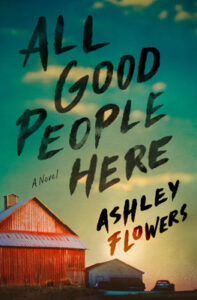 All Good People Here by Ashley Flowers
All Good People Here by Ashley Flowers Genres: Crime, Fiction, Mystery, Mystery Thriller, Thriller
Published by Random House Publishing Group on February 16, 2022
Format: Hardcover
Pages: 336

#1 NEW YORK TIMES BESTSELLER • In the propulsive debut novel from the host of the #1 true crime podcast Crime Junkie, a journalist uncovers her hometown’s dark secrets when she becomes obsessed with the unsolved murder of her childhood neighbor—and the disappearance of another girl twenty years later.
ONE OF THE BEST BOOKS OF THE YEAR: PopSugar
You can’t ever know for sure what happens behind closed doors.Everyone from Wakarusa, Indiana, remembers the infamous case of January Jacobs, who was discovered in a ditch hours after her family awoke to find her gone. Margot Davies was six at the time, the same age as January—and they were next-door neighbors. In the twenty years since, Margot has grown up, moved away, and become a big-city journalist. But she’s always been haunted by the feeling that it could’ve been her. And the worst part is, January’s killer has never been brought to justice.
When Margot returns home to help care for her uncle after he is diagnosed with early-onset dementia, she feels like she’s walked into a time capsule. Wakarusa is exactly how she remembers—genial, stifled, secretive. Then news breaks about five-year-old Natalie Clark from the next town over, who’s gone missing under circumstances eerily similar to January’s. With all the old feelings rushing back, Margot vows to find Natalie and to solve January’s murder once and for all.
But the police, Natalie’s family, the townspeople—they all seem to be hiding something. And the deeper Margot digs into Natalie’s disappearance, the more resistance she encounters, and the colder January’s case feels. Could January’s killer still be out there? Is it the same person who took Natalie? And what will it cost to finally discover what truly happened that night twenty years ago?
Twisty, chilling, and intense, All Good People Here is a searing tale that asks: What are your neighbors capable of when they think no one is watching?
A strong opening chapter followed by a lot of slow plodding around sleepy Wakarusa, Indiana, I had my doubts about All Good People Here being able to close things out and salvage itself after a very lackluster first half. Fortunately I thought it did just that once Ashley Flowers’ background in True Crime podcasting pick up in the last third of the book and lends itself to a successful and at times exciting resolution.
My biggest gripe with All Good People Here lies with the main protagonist leads and the perspectives of Margot Davies in the present 2019 and Krissy Jacobs in the past beginning with her childhood and the sequence of unfortunate events in 1994. For me personally it felt like the two women were in constant competition of who was more insufferable to read about and who would make the unintelligent emotion-driven decision at any given moment (which is quite counterintuitive for a supposedly successful journalist). I realize this is to show character development and growth; for Margot it’s to show growing validation for her initially off-base preconceived assumptions on the case and for Krissy, to show a young adult trapped and spiraling in a life she never wanted. Both goals are ultimately accomplished at the cost of losing any little care I had for either of them. This is exacerbated by how slow the plot moves during the early character-driven chapters that introduce the residents of Wakarusa and provide the reader context for the general feel and social workings of small rural communities. The material is technically good and Flowers/Kiester (co-writer or ghost writer? Hm…) do a good job portraying the sleepy town, it’s just not particularly interesting for me to read.
However once the case starts going, the novel because a real page-turner. The investigation falls into expected procedural tropes, but I don’t necessarily mind that as they’re done in a purposeful way. The investigation constantly follows the expected narrative of a new piece of evidence incriminating a suspect, casting the spotlight and suspicion on them, and then disproving it with a a new piece of evidence and suspect; this is nothing new. However the resolution to the case is executed in a way that ties every potential suspect together in a sequence of events that is not only compelling but actually makes sense (which is a surprisingly difficult aspect that many contemporary “mystery” novels I’ve read lately fail to pull off). I was very close to hurling this book at the wall when the supposed killer was revealed and arrested with how mediocre the motive and connections were set up, but an extremely last minute 180 unrevealing the true killer in the last 15-20 pages left me pleasantly surprised and convinced me to barely bump this up to a four star from an original 3-star (though honestly, this was a 2-star for most of my readthrough). The killer was still the original person I suspected, but the path the narrative took to get there had a lot of plot twists that were surprising without feeling like they came completely out of left field.
For many readers, there is of course the elephant in the room which is the seemingly abrupt and vague ending. Without giving away spoilers, you’re left wondering what happens to one of the main characters and whether the true killer is caught. I personally really liked the ending; it’s open-ended by design and leaves the reader with the following quote:
“There was nothing she wouldn’t do… to keep *redacted* from turning her into one- just another forgotten girl added to another list.”
Yes the reader is not explicitly told what happens to her nor do you know if the killer is caught. However this type of ending perfectly matches the style of True Crime podcasts, documentaries, and even some crime drama tv-shows or movies. The included epilogue chapter fully explains the killer’s motive, frame of mind and actions leading up to the focal death of January Jacobs. I found this ending to be and on-brand for a murder mystery novel, however I understand how polarizing it can be for casual or bookclub-focused readers who want a clear and explicit ending (feel-good ending this most definitely is not). Perhaps my overly positive impression of the ending is heightened when compared to the ending of A Flicker in the Dark that I recently read which somehow manages to have a clear arrest of the killer while also squandering just about every other aspect of a proper ending for sake of emotional resolution of one character.
To summarize, All Good People Here would be great if not held back by its two main characters (too emotionally volatile and unintelligent for me but probably relatable for more emotionally-oriented readers). The writing is merely functional and not particularly strong, but with a solid plot in the 2nd half of the novel, it almost doesn’t matter as long as you don’t DNF before getting to it. Yes this novel borrows a lot of familiar tropes, investigative details or even similarities to actual true crimes (it’s obviously inspired and heavily influenced by the killing of JonBenét Ramsey), but to me it feels more like a homage to those sources rather than blatant ripoff that a lot of other reviewers believe. Perhaps I had low expectations based on how poorly I felt about this initially, but this was a surprisingly decent read that I don’t regret picking up.
